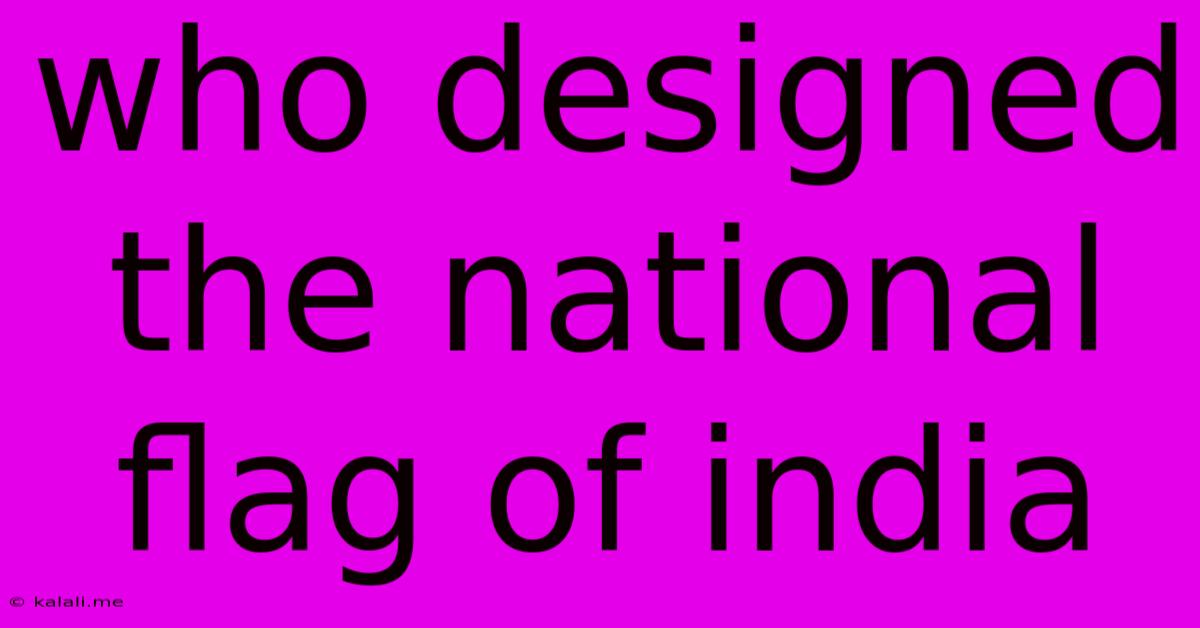Who Designed The National Flag Of India
Kalali
Jun 14, 2025 · 3 min read

Table of Contents
Who Designed the Indian National Flag? A Look at Pingali Venkayya's Contribution
The Indian national flag, with its vibrant saffron, white, and green bands and the Ashok Chakra in the center, is a powerful symbol of the nation's identity and pride. But who was the creative mind behind this iconic design? While the flag's adoption was a collaborative effort, the design itself is largely attributed to Pingali Venkayya. This article delves into the story of this unsung hero and the fascinating journey of the Indian flag's creation.
Pingali Venkayya: The Architect of the Tricolour
Pingali Venkayya (August 2, 1876 – November 4, 1963) was an Indian freedom fighter and textile designer. He wasn't just a designer; he was a dedicated nationalist deeply involved in the Indian independence movement. His profound understanding of Indian symbolism and aesthetics played a crucial role in shaping the national flag. His design wasn't adopted overnight; it evolved through discussions and iterations within the Indian National Congress.
The Design's Symbolism: A Blend of Tradition and Modernity
Venkayya's design incorporated elements that held significant meaning for India. The saffron color represents courage, sacrifice, and renunciation; white signifies peace and truth; and green symbolizes faith, fertility, and prosperity. The Ashok Chakra, a 24-spoke wheel, depicts the Dharma Chakra, symbolizing the "Wheel of Law" and represents righteousness and progress. The placement of the Chakra at the center of the white band balanced the colors and further enhanced the flag's symbolism.
The Process of Adoption: From Design to National Symbol
While Venkayya is credited with the design, the flag's eventual adoption was a result of a collective effort by the Indian National Congress. The committee debated various design proposals before settling on Venkayya's design, with some minor modifications. The flag's official adoption came on July 22, 1947, just before India gained independence. This process highlights the collaborative nature of nation-building and the importance of consensus in establishing national symbols.
Beyond the Flag: Venkayya's Other Contributions
Beyond his contribution to the national flag design, Venkayya played a crucial role in other facets of the Indian independence movement. His involvement showcased a commitment to a free India that extended beyond just symbolic representation. He was a staunch advocate for swaraj (self-rule) and participated actively in various movements against British rule.
Recognizing Venkayya's Legacy: A Fitting Tribute
Despite his significant contribution, Venkayya's role in designing the Indian national flag remained relatively unknown for a considerable period. In recent years, there has been a growing effort to recognize his contribution and celebrate his legacy. His story serves as a reminder of the unsung heroes who played a crucial role in shaping India's identity. His dedication to the nation's cause and his profound understanding of symbolism made him instrumental in creating a powerful and enduring national emblem. The Indian flag, a powerful symbol of national pride and unity, is a lasting testament to his vision and artistry.
This article helps users understand the history behind the Indian National Flag and the key role played by Pingali Venkayya in its design and adoption. Remember to always cite your sources when using this information in your own writing.
Latest Posts
Latest Posts
-
Is A Zooplankton A Primary Consumer
Jun 15, 2025
-
Of The Following Which Atom Has The Largest Atomic Radius
Jun 15, 2025
-
Difference Between Capital And Consumer Goods
Jun 15, 2025
-
Which Of The Following Items Is An Example Of Software
Jun 15, 2025
-
Which Of The Following Pairs Are Synonyms
Jun 15, 2025
Related Post
Thank you for visiting our website which covers about Who Designed The National Flag Of India . We hope the information provided has been useful to you. Feel free to contact us if you have any questions or need further assistance. See you next time and don't miss to bookmark.